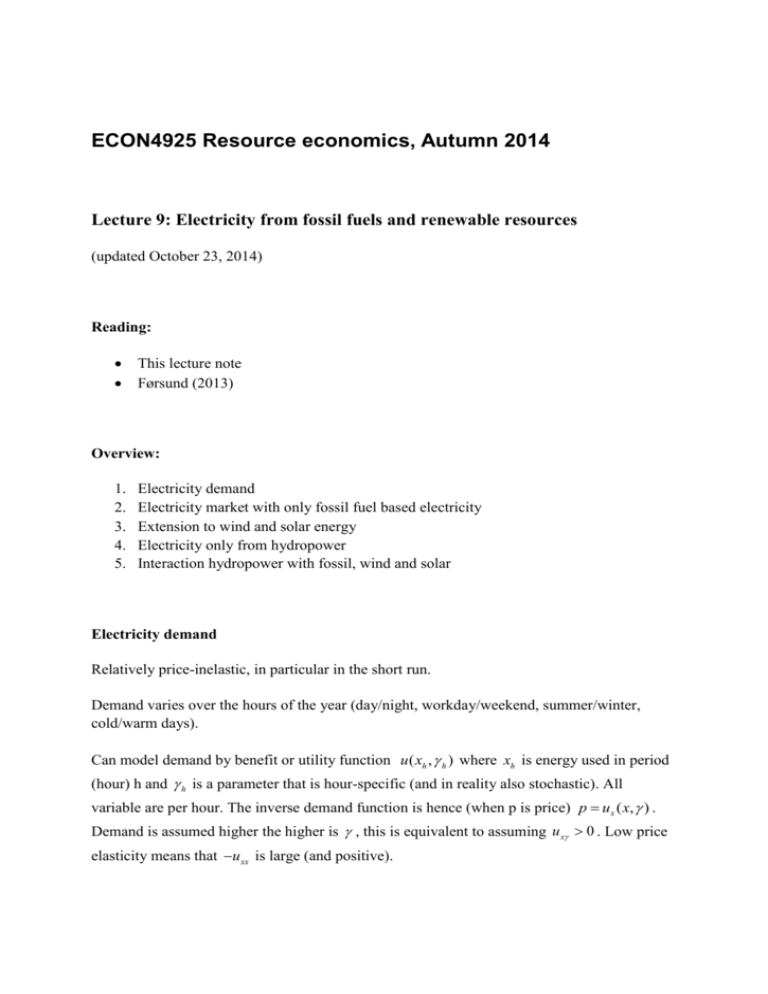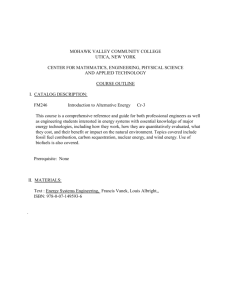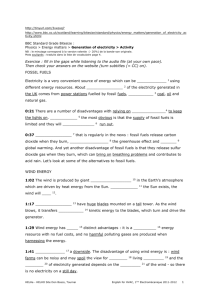Lecture 9
advertisement

ECON4925 Resource economics, Autumn 2014 Lecture 9: Electricity from fossil fuels and renewable resources (updated October 23, 2014) Reading: This lecture note Førsund (2013) Overview: 1. 2. 3. 4. 5. Electricity demand Electricity market with only fossil fuel based electricity Extension to wind and solar energy Electricity only from hydropower Interaction hydropower with fossil, wind and solar Electricity demand Relatively price-inelastic, in particular in the short run. Demand varies over the hours of the year (day/night, workday/weekend, summer/winter, cold/warm days). Can model demand by benefit or utility function u ( xh , h ) where xh is energy used in period (hour) h and h is a parameter that is hour-specific (and in reality also stochastic). All variable are per hour. The inverse demand function is hence (when p is price) p ux ( x, ) . Demand is assumed higher the higher is , this is equivalent to assuming u x 0 . Low price elasticity means that u xx is large (and positive). 2 Fossil fuel based electricity Long-run supply much more price sensitive in long run (capital input is endogenous) than in short run (given capacity). In long run horizonal supply curve is a realistic assumption. Shortrun supply curve is steeper for coal than for gas, as it is easier to quickly adjust output with gas than with coal. Both the short-run and long-run supply curve will depend on the fuel price and the price (if any) of carbon emissions. Over the year, the equilibrium price will vary over different hours due to the demand variation. It is the short-run supply curve that is relevant for the hour-to hour variation in output. Wind and solar energy Both are characterized by negligible variable costs for a given capacity. We may define capacity y (measured in kW) as the output per hour under best possible wind/sun conditions. Actual output in any hour will be wh y where wh is exogenous and wh 0,1 (with wh =0 for no wind/sun). Note that the size of wh is more predictable for solar than for wind (e.g. day/night). The short-run equilibrium will be characterized by (1) u ( xh wh y, h ) cx ( xh , K ) ph ( xh wh y ) where c ( x, K ) is the cost function of fossil fuel based electricity for a given capital stock K. From the assumed properties of the functions it follows that ph is higher the higher is h and the lower is wh . Also, an increase in wind/solar capacity (i.e. increased y) gives a lower equilibrium price for all hours. Similarly, an upward shift in the marginal cost function of fossil fuel based electricity (e.g. due to increased fuel prices or a higher price of carbon emissions) will give a higher equilibrium price for all hours. In the long run, y is endogenous. Let the capital cost per year of wind or solar be b(y), with b’>0 and b’’>0. The latter assumption is because relevant sites for wind and (to a lesser extent) solar vary in quality (i.e. how much output for a given installation). As capacity increases, one has to use sites with lower quality, hence costs increase. The long-run equilibrium is characterized by h ph wh b '( y ) 3 The long-run equilibrium value of y may be affected be either subsidizing investment costs or by subsidizing output. Similarly, in the long run the capital stock K used in fossil fuel based electricity is endogenous, chosen to minimize total costs. Hence, (2) c h K ( xh , K ) 0 Assuming a horizontal long-run supply curve is equivalent to assuming that c(x,K) is homogeneous of degree 1 in x and K, i.e. that c( xh , K ) xh cx ( xh , K ) KcK ( xh , K ) . Together with (1) and (2) this gives (3) h c( xh , K ) h xh px x h h h h h In other words, long-run unit costs over a year are equal to a weighted average of the electricity price through the year Hydropower The simplest case is to assume that all water inflow occurs at the start of the year. In Norway the start of a year would be late April/early May, see figure from http://vannmagasinfylling.nve.no/ 4 Let R be total water inflow to the reservoirs (we take the size of the reservoirs as given). The social optimum (and competitive equilibrium) is given as the solution to max h u ( zh ) s.t. h zh R giving p uz ( zh , h ) being independent of h. So the price will be constant throughout the year (and lower the higher is R), while output will fluctuate with h. Even if there are no other constraints than h zh R , R will in reality be uncertain. As time passes, we continuously make updated predictions about R. For each update it is rational to reoptimize for the remaining hours of the year. Each reoptimization will in principle give a new constant price for the rest of the year. Hence, actual price over the year will fluctuate. Førsund considers various extensions. We shall consider two of these. One is a constraint zh z and the other is Rh R where Rh is the reservoir in the end of period h, given by the dynamic equation Rh Rh1 I h zh 5 where I h is water inflow in period h. These two extensions will be discussed in the lecture, and are also discussed by Førsund. Interaction hydropower with fossil, wind and solar We now only consider the simplest case described above, i.e. h zh R being the only constraint for hydropower. If hydro is large relative to the whole system (and there are no transmissions constraints), all demand and wind/solar variation will be balanced by hydropower, so the equilibrium price will be constant over the year. Formally, this follows from solving the following problem (for given y and K): max h u( xh wh y zh , h ) c( xh , K ) s.t. h zh R More realistically, hydro is small (Norway) while fossil and wind/solar is large (Germany). Moreover, there are transmissions costs and hence a transmission capacity constraint between hydro and fossil/wind/solar. Assume that the hydro part is so small that prices in the fossil/wind/solar part can be regarded as given. Assume moreover that there is a transmission capacity constraint so that maximally k units of energy can be transmitted between the two systems at each hour. The optimization problem for Norway (the hydro part) is then (with n denoting net exports) max h u ( zh nh , h ) ph nh s.t. h zh R and k nh k Let hours be numbered so ph is declining in h. The solution to the problem above is then characterized by u’ being constant, and export at full capacity for all hours that ph u ' and import at full capacity for all hours that ph u ' . Let h* be the largest h satisfying ph u ' . Then total equilibrium net export through the year (consisting of 8760 hours) is h*k (8760 h* )k (2h* 8760)k . This number may be positive or negative, and is proportional to the capacity k for a given h* (note however that h* will generally depend on k). Net export over the year is larger the larger is h*. A shift upwards in German prices will increase h*, while an increase in Norwegian demand or lower inflow R will reduce h*. Two figures that illustrate the points above are found in http://www.vista-analyse.no/no/publikasjoner/avkastningskrav-ved-investering-i-kabler-tilengland-og-tyskland/ 6






